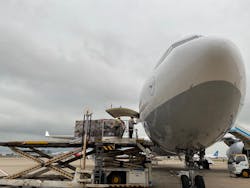As airline passenger figures dipped this spring as a result of travel restrictions spurred by the COVID-19 pandemic, cargo demand remained high.
However, a capacity crunch was preventing cargo demands from being fully met.
Reacting quickly, many airlines pivoted and began the process of commissioning passenger aircraft to carry cargo, including mail, medical supplies, personal protective equipment (PPE) and other goods. But before these aircraft, colloquially referred to as “preighters,” can take flight, several safety details must be considered.
The International Air Transport Association (IATA) has provided direction to airlines in a document titled “Guidance for Safe Transport of Cargo in Passenger Cabin,” reminding operators to conduct a safety risk assessment when repurposing aircraft. IATA officials note all safety regulations associated with a change in aircraft utilization must be complied with before utilizing the passenger cabin of an aircraft for carrying cargo.
IATA also notes that modifications to the passenger cabin, such as the removal of passenger seats, must be approved by an airline’s National Aviation Authority and all operations procedures need to be documented and properly published.
Among other details, IATA’s general recommendations also include using crew members to survey all areas of the cabin during the flight and ensuring the crew has access to those areas in the case of fire or other unanticipated event.
“Besides an approval from the responsible authorities, the layout of the aircraft needs to be changed and the operating organization has to do a risk evaluation and has to approve the conversion as well,” notes Judith Wedlich-Blender, project leader for the conversion of aircraft at Lufthansa Cargo.
Wedlich-Blender explains there are three allowable scenarios for loading cargo in the passenger section of an aircraft.
One option is for cargo to be stored on seats, between seats and in bins. Cargo can also be stored in specific seat containers or seat bags. The third option is for cargo to be secured on the floor when the aircraft’s seats are removed.
“Technical Standard Orders (TSO) certified nets and lashing belts, or tie down straps, are used to secure cargo on passenger seats on the floor of the passenger cabin,” add officials at Emirates.
Only certain cargo is allowed in passenger compartments, explains Wedlich-Blender. She points out this is a safety issue for a number of reasons. For example, the fire extinguishing system in the passenger cabin is not as specific as those located in cargo aircraft.
IATA’s guidance notes that dangerous goods and cargo-aircraft-only dangerous goods cannot be transported in a passenger cabin. Rather, they must be carried in the cargo compartment and only if the operator carries their National Aviation Authority’s approval to do so.
“Special procedures have been developed to comply with safety and security standards,” says Wedlich-Blender.
Emirates officials note that special guidelines regarding the positioning and usage of various ground support equipment (GSE) to assist with the loading and unloading of cargo on the converted aircraft are in place for ground service providers. These guidelines ensure a safe and efficient aircraft turnaround.
Examples of these new GSE guidelines include revised loading and unloading sequences to maintain aircraft ground stability and guidance on the docking and usage of main deck loaders (MDLs) on the cabin service doors.
“The loading and unloading sequence was adjusted in consideration of aircraft ground stability and aircraft turnaround efficiency,” say officials at Emirates. “Simultaneous loading and unloading of cargo in certain compartments as well as the cabin could be achieved in support of a safe and efficient turnaround.”
Wedlich-Blender explains that depending on authority approval and the specific airline, the type of cargo that can be transported in a preighter is limited. Emirates officials note that standard GSE, such as MDLs, passenger steps and aircraft catering trucks, can be utilized in the transportation of cargo items between the apron and passenger cabin for loading and unloading.
Still, the loading and unloading process can be demanding.
“On average, we require between 12 to 20 agents to load and/or offload the cabins,” explain officials at Emirates. “There are many variables on which these numbers depend, including the type of ground support equipment that is being used to load/offload the cabin.”
“When handling converted passenger aircraft, a lot of manual work is needed, which is more time- and resource-consuming, compared to the handling of freighters,” agrees Wedlich-Blender. “This results in increasing ground times of the converted aircraft.”
IATA reminds its member airlines that monitoring subcontractors and the cargo services they perform is critical so that cargo is transported safely.
Officials at IATA say the airlines' innovative response to such an unprecedented global health crisis ensured that vital medical supplies were able to move in a quick and safe fashion to help the fight against the COVID-19 pandemic.
About the Author
Josh Smith
Editor
Josh Smith served as editor of Ground Support Worldwide as editor from 2016 through 2024. He oversaw production of the print magazine, created GSW's newsletters on a daily basis, and updated the latest news on AviationPros.com.

